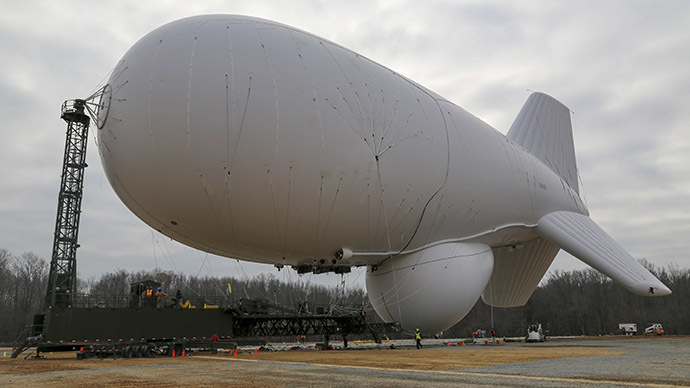Pentagon launching missile defense blimps to patrol East Coast

The US Army is set to begin testing its blimp-like surveillance airships, designed to help the military detect and destroy cruise missiles from attacking the nation’s capital and other East Coast cities.
The blimps at the center of the tests in Maryland are unmanned, 80-yard long, helium-filled aircraft that can float up to 10,000 feet in the air. At that height – a third of the cruising altitude for commercial airliners – they will patrol the skies above major East Coast cities for three years.
During the testing, one aircraft – also called an aerostat – will scan in an area from New York to North Carolina’s Outer Banks, and as far west as central Ohio. The other blimp will carry radar to help the military on the ground pinpoint targets.
READ MORE:Army refuses to open up on capabilities of surveillance blimps over Maryland
The system is called JLENS, short for Joint Land Attack Cruise Missile Defense Elevated Netted Sensor System. The radar is used to spot missiles or “swarming boats” filled with explosives from as far away as 340 miles. The army said the blimps won’t carry weapons, as enemy missiles would be destroyed by air-, ground- or ship-based weapons.
"We can defeat cruise missiles but we have limited capability to detect. And so, with an elevated sensor, such as JLENS, and the ability to look out over the horizon, now we have the ability to detect and to enable our systems to defeat cruise missiles," Maj. Gen. Glen Bramhall, commander of the 263rd Army Air and Missile Defense, told The Associated Press.
The plan is to fully deploy the blimps next spring, with them traveling together four miles apart and tethered to slabs of concrete. The aircraft are built by Raytheon Co., in Massachusetts, and TCOM L.P. in Maryland.
READ MORE:Mini spy-craft: US Army working on pocket-sized surveillance drones
The project has cost the government about $2.8 billion so far, with Congress approving another $43.3 million last week for the first year of the test. Proponents say the JLENS will save the government and American taxpayers money in the long run by reducing the need for surveillance by conventional aircraft.
"The analysis we've done says it's about five to seven times less than operating a fleet of aircraft to cover the same area over the same time period," said Douglas Burgess, Raytheon's JLENS program director
Privacy advocates, though, worry that JLENS could easily be used to monitor citizens, possibly with the use of sophisticated facial recognition cameras. Documents from 2009 describing JLENS capabilities were offered to the Electronic Privacy Information Center (EPIC), yet those documents came so heavily redacted that they did not outline exactly how the system will be used, stoking an ongoing legal battle to compel more information.
“There is a lot of potential for privacy abuse if a surveillance device can identify a human at five kilometers away,” said Julia Horwitz, EPIC’s consumer protection counsel.
David Rocah of the American Civil Liberties Union in Maryland said privacy advocates were leery of the airships' ability to constantly monitor moving objects, including cars on the ground. Bramhall said the radar can't identify individuals or record cellphone conversations.
"The mission is not to spy on US citizens,” he said. “It is not designed for that.”












